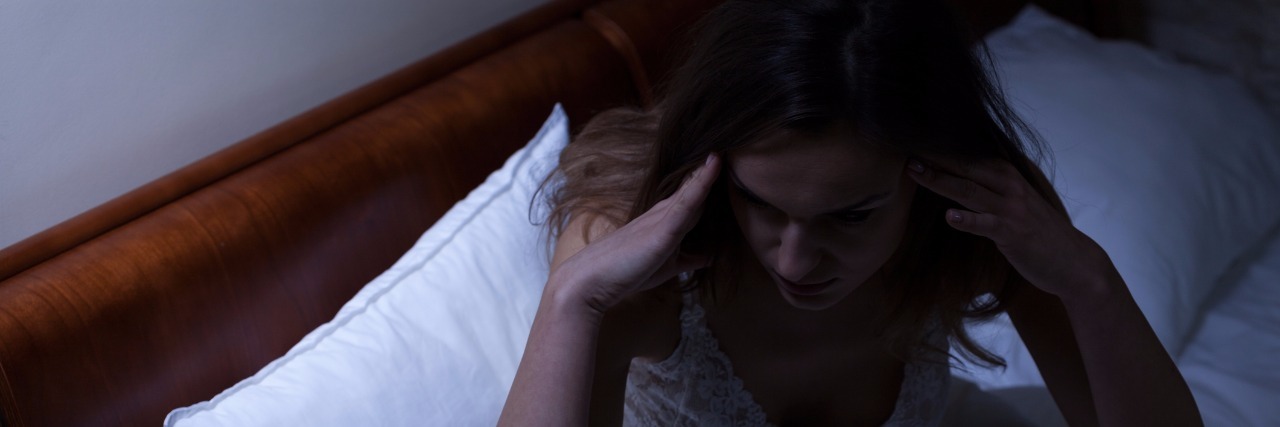As an occupational therapist with hypermobile Ehlers-Danlos syndrome, “painsomnia” (pain-induced insomnia) is something I come across a lot. I work with a lot of people who have pain; I also live with it. In fact, I had no idea chronic pain wasn’t “normal” until I was 19. I genuinely thought everyone was in pain all the time. Pain is my normal, so it must be the same for everyone right? Seems not.
• What is Ehlers-Danlos Syndrome?
• What Are Common Ehlers-Danlos Syndrome Symptoms?
Still, there are some upsides. Living life as a patient taught me a lot about being a health care professional. Anyway, back to painsomnia.
It’s getting late. My partner works an early morning shift so we’ve agreed the latest I’ll come to bed is 2 a.m. That way he’s got time to fall back to sleep properly before work. Trouble is, I’m a night owl. Some of my best work is done at 1 a.m.
I head to bed and creep around the room trying not to trip over things in the gloom and going about my nightly routine.
As I go about my routine, I run over my nightly checklist. Did I take my meds? Do I want any extras? If the room too hot? Do I want the windows open? Pajamas or not? Do I braid my hair or leave it down? Which pillows do I want? Does my back hurt enough to sleep in a corset? Is there a drink within reach of the bed?
These things might seem inconsequential but, really, they’re pretty important. You see, I have to prepare for the worst and hope for the best. Sharing a bed is great, but it’s also quite warm, especially in the summer. Too warm can be disastrous. My postural orthostatic tachycardia syndrome (POTS) makes me really heat intolerant. Too hot and my heart rate starts to creep up. Too warm and I lose the ability to think straight. Too warm and I end up drenched in sweat, dehydrated, and semi-conscious.
Eventually I decide what to wear, what to do with my hair, what windows should be open, I’ve made and drink and I’ve taken all my pills. I’ve selected my pillows and I’m ready for phase two.
Once I’ve decided on my environment, it’s time to actually get into bed. My shoulders sublux if I sleep on my side, but if I sleep flat on my back the natural curve of my spine collapses and I end up with numbness, severe pain or temporary paralysis… fun, right?
If I sleep on my side I can’t relax or my hips cause problems. So I have a maternity pillow with extra lumbar support, I’ve got a pillow to go under and between my knees, and another one to prop up my wonkier shoulder. I’ve made it into bed, surrounded by pillows.
Trouble is I still can’t get comfy. After a while I roll over stealthily, so as not to lose track of my pillows or wake my slumbering boyfriend. This new position is better for my back but worse for my shoulder, so I change the pillow arrangement and try to think of something besides the pain. I count sheep, make up stories in my head, run through relaxation protocalls, and generally try to avoid thinking about the time.
After another three position changes I’m finally starting to feel genuinely sleepy.
Just as I’m about to fall asleep the cramps set in. Nocturnal cramps (mostly in my legs) have been an issue since I was about five. I’m told I’ll grow out of them, but at 26 years old I’m starting to doubt that.
I run through the relaxation protocols again. I try some very stealthy ninja-like bed yoga, but after 20 minutes, I still struggle. I struggle my way past the pillows, blankets, and my sleeping boyfriend and get out of bed.
It’s now 3 a.m. and I’m sitting on the floor with a bottle of magnesium oil. I’m running through floor-based yoga stretches and trying some self-massage while still trying to be super-stealthy. I’m hooked up to my TENS machine trying to zap the pain away.
It’s at this point I usually decide sleep isn’t worth the effort, but unfortunately, without a minimum of 10 hours I’m limited on what I can do the next day. I work flexible hours from home, but I do still have to work. I also need energy for physical therapy, and I’d love to have a social life too.
I could take some of my emergency meds now, but it’s 3:45 a.m. and now the meds will zonk me out for half the day. So, nope. Meds are out. I persevere with the yoga and at 4:30 a.m. my boyfriend’s alarm goes off for work. He wakes up and I’m still sitting on the floor. It’s been a horrendous night and he’s slept through all of my tossing, turning, fidgeting, pillow exchanges, and bed yoga.
You see, my boyfriend is one of those truly magical people who can fall asleep at will. He decides to go to sleep and he just does. No pillows, pills, outfit changes, or extra measures needed. Give him a 30 minute break and he’ll sleep for 27 minutes of it. It’s like a super power. One I definitely cannot replicate.
The good news? This doesn’t happen very often; I usually manage to get to sleep after about an hour of trying. The coping strategies I’ve learned (and teach to others) help massively, and generally my pain is under control better than it has ever been.
The bad news? I have no control over when it does happen.
There is one upside to all of this that I genuinely think is wonderful. When my patients tell me about their horrible experiences, I get to say something most medical professionals can’t.
“I understand.”
Thinkstock Image by KatarzynaBialasiewicz

